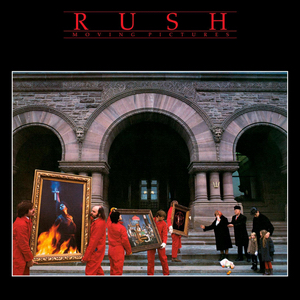This is the album that begins with “Tom Sawyer”, another one of their most recognizable songs, and based mostly on a single drone. Then we have a song about a car, in this case a mispronounced “Red Barchetta”, given an extremely picturesque arrangement that changes gears just like all the best (and worst) songs about cars do. Every teenage guitarist worth his salt just had to master that harmonics riff, being one of the few Alex Lifeson parts that doesn’t require speed to impress. Trainspotters love to explain the significance of “YYZ”, its Morse code tempo giving each of the band members room to show off. A Zeppelinesque hook introduces “Limelight”, practically a pop song and one of Neil Peart’s most personal, ironic, and often misinterpreted lyrics.
It’s such a perfect album side that many spotty youths we know played it way more than the flip, often skipping right to “Witch Hunt” in the middle of side two. It was their loss, which they would all realize once the charms of “The Camera Eye” were allowed to be heard. A two-verse song contrasting and comparing two iconic cities isn’t any literary leap, particularly when the cities in question are Manhattan and London, but they can be a pretty big deal to anyone seeing them for the first time. The verses are almost secondary to the main thrust of the song, with its grandiose swoop and cinematic breadth. Still, at eleven minutes most D&D players would have been more impressed by the sinister undertones and gothic overtones of “Witch Hunt”, and since “Vital Signs” even got airplay on MTV, most of the kids were able to keep up with the backwards reggae beat and tricky stop-time.
Even the band themselves know how large Moving Pictures looms in their legend, going so far as to spotlight it on tour some 30 years after its initial release. There’s nothing silly or embarrassing here, but there is some well-placed humor, both in the music and on the cover. Again, of all their catalog, this is the one album every Rush fan can agree on, and the best entry point.
The 30th anniversary of the album was commemorated with a deluxe edition of the CD packaged with the consumer’s choice of DVD or Blu-ray with 5.1 surround mixes and the original videos for three of the songs. Ten years later, their anniversary editions had become more elaborate, so the Deluxe Edition of Moving Pictures got new artwork plus a full concert from the Toronto stop of the tour, cleverly designated Live In YYZ 1981. (Besides being more comprehensive than what would comprise their next live album, it’s essential for the medley towards the end of the set, which begins with a reggae arrangement of “Working Man”.) The Super Deluxe Edition added vinyl versions of the album and concert, plus a Blu-ray, book, and ephemera including picks, drumstick, and a red model Barchetta.
Rush Moving Pictures (1981)—4
2021 40th Anniversary Deluxe Edition: same as 1981, plus 19 extra tracks

No comments:
Post a Comment